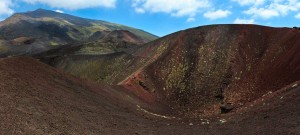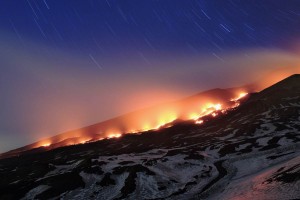
©Bigstock.com/j-wildman
So stunning yet so terrifying: Hardly any other Italian tourist attraction lets extremes collide quite as spectacularly as Mount Etna. Europe’s tallest volcano is located on the island of Sicily and still spits fire quite regularly. Still – or maybe because of it –, the dangerous spectacle of nature attracts a lot of people from all over Italy and the rest of the world year after year. But what is it that makes the UNESCO World Natural Heritage Site so lastingly popular? Learn more about Etna’s history, its environmental impact, and the various hiking and trekking options to the summit crater here.
Facts and figures
Presumably formed in a bay on the eastern Sicilian coast due to volcanic activities on the sea ground approx. 600,000 years ago, Mount Etna is regarded as both Europe’s tallest volcano and the island’s highest peak at approx. 3,323 m. Four summit craters and around 400 adventitious craters cover an area of about 1,250 km², surrounded by the national park Parco dell’Etna, which protects the unique nature around the volcano from planned touristic and economic development. The composite volcano itself is made up of basalt. The exact structure and composition of the individual craters change from eruption to eruption. Thus, height, circumference and the number of craters can never be determined exactly and should best be seen as an approximate snap-shot. A rather characteristic feature of Mount Etna is the comparatively still main crater: Most of the volcanic events occur through the other three large craters and the various smaller adventitious craters.
Devastating eruptions

©Bigstock.com/ollirg
Mount Etna is active to this day emitting ash and lava in almost regular intervals. Geological research determined a massive eruption around 1500 BC. A later eruption supposedly drove away the Sicani inland leading to the settlement of the Sicels which contributed to a massive cultural rupture throughout Sicily. Mount Etna’s volcanic events destroyed Catania multiple times, the first documented one dating back to around 693 BC. A severe eruption in 44 BC even covered the sky over Rome in thick ash clouds resulting in devastating crop failures ranging as far as Egypt.
Mount Etna also played a rather devastating role in post-Christian times. Catania fell victim of several disastrous eruptions, such as the years 252 to 253. The volcanic event from 8 March to 11 July 1669 is the most devastating of its kinds. Beyond severe destructions in Catania and the surrounding villages, the lava flow destroyed the coastal town of Castello Ursino and moved the fort of the same name inland by several hundred metres. To this day, seismic activities regularly create disturbances and destructions. It is very unlikely that the Etna region will ever find peace.
Between tourist attraction and polluter
According to a Sicilian proverb, Mount Etna is both fertile and terrible. It is environmentally sound and pollutive at the same time. As fertile and the land around the craters and ripples might be, the massive eruptions annually emit around 25 million tons of carbon dioxide into the atmosphere making the volcano one of the planet’s worst polluters. Simultaneously, Mount Etna is probably Sicily’s most important tourist attractions, not just because of the countless crater tours leading into dangerous territory. There’s even a small ski region south of the summit crater at around 2,600 m operating non-stop from November to April. Accompanied by columns of smoke, skiers and boarders take mostly intermediate slopes back into the valley near Nicolosi.
The nature reserve
The huge popularity of Mount Etna lead to extensive touristic development over the last decades. In order to prevent complete commercial construction development, the nature reserve Parco dell’Etna was established in 1987. The regional park around the volcanos stretches across an area of 58,905 hectares encompassing 20 municipalities. The Etna region is home to around 70 different bird species, wolves, red deer, porcupines, foxes, martens, dormice, rabbits and wild rabbits. Furthermore, Europe’s probably oldest and thickest tree stands on the east slope of the volcano. Experts estimate the age of the Hundred-Horse Chestnut at around 2,000 to 4,000 years!
Crater and volcano tours
You’d like to experience the spectacular crater areas at close range while feeling a healthy thrill? Numerous providers lead you to the deep ripples and smoking magma chambers on Mount Etna – certainly depending on both the weather and potential seismic and/or volcanic activities. The two tourism centres Etna-Nord and Etna-Sud are the best points of references for your tours. While you can hike the volcano yourself, supported by cable car or jeep ascents, you are only allowed to the summit crater in the company of a trained mountain guide. You need a certain level of endurance for longer hiking and trekking tours, as there are around six hours of tricky terrain waiting for you. We strongly advise asthmatics and heart cases against crater tours! Try hiking through lower volcanic areas or the regional park instead. Dense pine tree forests and tall chestnuts alternate with lava flow and crater cones.
The UNESCO World Natural Heritage Site Mount Etna combines adrenalin-pumping thrills with idyllic nature like no other place in Italy – a place that certainly should play an important role in your holiday plans. Find many other travel suggestions around the volcano on ZAINOO. When will you book your adventure trip?